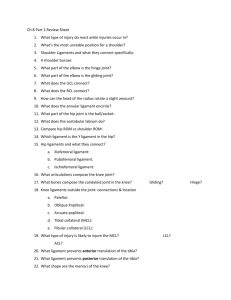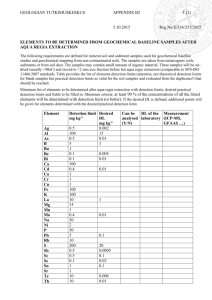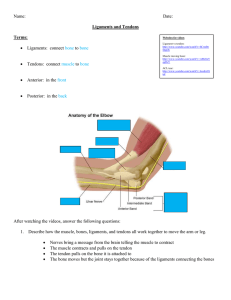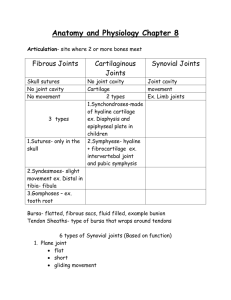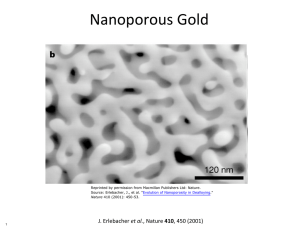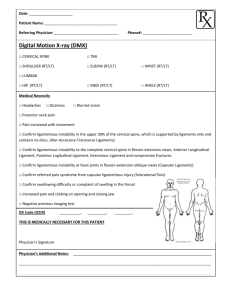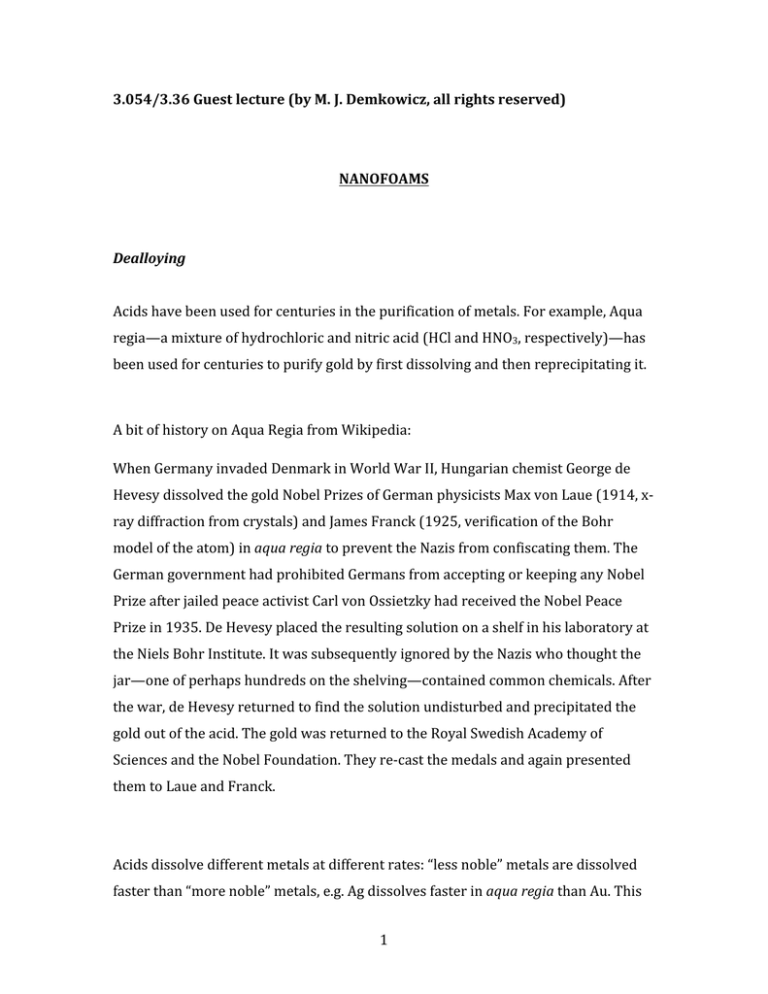
3.054/3.36
Guest
lecture
(by
M.
J.
Demkowicz,
all
rights
reserved)
NANOFOAMS
Dealloying
Acids
have
been
used
for
centuries
in
the
purification
of
metals.
For
example,
Aqua
regia—a
mixture
of
hydrochloric
and
nitric
acid
(HCl
and
HNO3,
respectively)—has
been
used
for
centuries
to
purify
gold
by
first
dissolving
and
then
reprecipitating
it.
A
bit
of
history
on
Aqua
Regia
from
Wikipedia:
When
Germany
invaded
Denmark
in
World
War
II,
Hungarian
chemist
George
de
Hevesy
dissolved
the
gold
Nobel
Prizes
of
German
physicists
Max
von
Laue
(1914,
x‐
ray
diffraction
from
crystals)
and
James
Franck
(1925,
verification
of
the
Bohr
model
of
the
atom)
in
aqua
regia
to
prevent
the
Nazis
from
confiscating
them.
The
German
government
had
prohibited
Germans
from
accepting
or
keeping
any
Nobel
Prize
after
jailed
peace
activist
Carl
von
Ossietzky
had
received
the
Nobel
Peace
Prize
in
1935.
De
Hevesy
placed
the
resulting
solution
on
a
shelf
in
his
laboratory
at
the
Niels
Bohr
Institute.
It
was
subsequently
ignored
by
the
Nazis
who
thought
the
jar—one
of
perhaps
hundreds
on
the
shelving—contained
common
chemicals.
After
the
war,
de
Hevesy
returned
to
find
the
solution
undisturbed
and
precipitated
the
gold
out
of
the
acid.
The
gold
was
returned
to
the
Royal
Swedish
Academy
of
Sciences
and
the
Nobel
Foundation.
They
re‐cast
the
medals
and
again
presented
them
to
Laue
and
Franck.
Acids
dissolve
different
metals
at
different
rates:
“less
noble”
metals
are
dissolved
faster
than
“more
noble”
metals,
e.g.
Ag
dissolves
faster
in
aqua
regia
than
Au.
This
1
behavior
is
exploited
in
a
separations
process
called
“selective
leaching”
or
“dealloying.”
Start
with
gold
leaf:
a
Ag‐Au
solid
solution
(Ag
and
Au
are
fully
miscible).
If
the
gold
leaf
is
submerged
in
an
acidic
solution,
the
Ag
is
eventually
dissolved
away
while
the
Au
remains.
The
leftover
Au
has
the
morphology
of
a
high
density,
on
open
cell
foam!
The
ligaments
in
this
Au
foam
are
very
short—on
the
level
of
a
few
tens
of
nanometers—and
have
a
low
aspect
ratio
(i.e.
their
thickness
is
comparable
to
their
length).
Thus,
dealloyed
Au
is
sometimes
referred
to
as
“nanoporous”
or
as
a
“nanofoam.”
Nanofoams
of
metals
other
than
Au
can
also
be
made
by
dealloying,
e.g.
Cu,
Ni,
and
Pt.
Surface‐to
volume
ratio
Because
of
their
small
ligament
sizes,
nanofoams
have
high
surface
area
per
unit
volume.
This
property
makes
them
promising
for
a
variety
of
applications
requiring
high
surface
area,
e.g.
catalysis,
sensing,
filtration...
Size
effect
in
mechanical
properties
The
strength
of
nanofoams
sizes
follows
the
Gibson‐Ashby
scaling
relation:
32
! !* $
! *pl
= C# & ! ys
" !s %
2
However,
this
relationship
is
a
phenomenological—rather
than
mechanistic—
observation:
it
does
not
imply
that
deformation
in
such
foams
is
localized
into
plastic
“hinges”
at
the
nodes
where
several
ligaments
meet.
Nanofoams
are
stronger
than
would
be
predicted
based
from
the
properties
of
bulk
Au
because
their
ligaments
have
higher
yield
stress
than
bulk
Au.
This
increase
in
strength
is
a
“size
effect”:
a
change
in
mechanical
properties
due
to
the
size
of
the
sample
being
deformed.
Three
mechanisms
that
can
lead
to
size
effects
are:
•
Reduction
in
size
of
dislocation
sources:
decreasing
ligament
size
increases
flow
stress
because
the
maximum
dislocation
source
size
is
limited
by
the
ligament
size.
The
stress
required
to
generate
new
dislocations
from
short
sources
is
higher
than
that
required
to
generate
dislocations
from
long
sources.
•
Dislocation
starvation:
increases
flow
stress
by
removing
dislocations
to
free
surfaces.
For
any
subsequent
deformation
to
occur,
dislocation
must
first
be
renucleated
from
the
surface,
which
generally
requires
much
higher
stresses
than
propagation
of
pre‐existing
dislocations.
•
Surface
tension
gives
rise
to
surface
energy‐induced
stresses.
The
effect
of
surface
tension
increases
with
decreasing
ligament
size.
Surface
tension
can
alter
the
flow
stress
of
nanofoams
by
pre‐stressing
the
ligaments.
The
effect
of
electrochemistry
Electrochemistry
influences
the
surface
tension
of
nanofoams,
which
in
turn
changes
the
strain
in
the
ligaments.
Based
on
this
effect,
potential
applications
of
nanofoams
in
environmentally‐induced
actuation
are
also
being
explored
(H.
J.
Jin
and
J.
Weissmüller,
Adv.
Eng.
Mater.
12,
714
[2010]).
3
It
has
also
been
found
that
the
mechanical
properties
of
nanofoams
can
be
reversibly
tuned
by
electrochemistry
(H.
J.
Jin
and
J.
Weissmüller,
Science
332,
1179
[2011]).
Coarsening
of
nanofoams
Nanofoams
can
reduce
their
surface
energy
by
coarsening,
i.e.
reducing
their
surface
area
per
unit
volume
by
increasing
their
ligament
size.
Surface
diffusion
is
the
most
commonly
proposed
mechanism
to
explain
coarsening
of
nanofoams
However,
some
aspect
of
nanofoam
coarsening
are
not
easily
explained
by
surface
diffusion:
•
Nanofoam
volume
decreases
upon
coarsening,
but
surface
diffusion
assumes
a
constant
number
of
lattice
sites
and
therefore
no
change
in
volume
•
Small
voids
completely
enclosed
in
ligaments
are
commonly
observed
in
nanofoams,
but
it
is
not
clear
how
surface
diffusion
can
lead
to
the
formation
of
such
voids
Network
restructuring
through
local
plastic
deformation
of
ligaments
is
a
coarsening
mechanism
that
addresses
the
deficiencies
of
the
surface
diffusion
model.
It
occurs
spontaneously
below
a
critical
ligament
size
and
leads
to
the
formation
of
enclosed
voids
(K.
Kolluri
and
M.
J.
Demkowicz,
Acta
Mater.
59,
7645
[2011]).
4
MIT OpenCourseWare
http://ocw.mit.edu
3.054 / 3.36 Cellular Solids: Structure, Properties and Applications
Spring 2014
For information about citing these materials or our Terms of Use, visit: http://ocw.mit.edu/terms.



